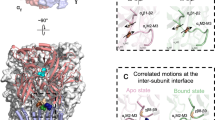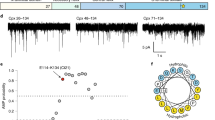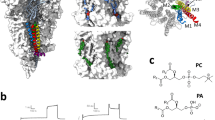Abstract
In the continued presence of cholinergic ligands, the acetylcholine receptor–channel complex (AChR) in postsynaptic membranes undergoes a sequence of conformational changes. On addition of the ligand, the receptor rapidly changes from a closed channel to an open channel conformation1, then slowly changes to a nonconducting state termed desensitization2,3. The lifetime of the open channel conformation4 and the rate of desensitization5 are both dependent on the magnitude of the membrane potential, suggesting that the ligand-induced conformational changes in AChR may involve the movement of electrical charges within the membrane6,7. Measurements of charge redistribution in AChR-containing membranes following ligand binding have not been reported. Recently, measurements of changes in the membrane partition coefficient of hydrophobic ions have been used to detect electrostatic changes in both biological8 and model9,10 membranes. We report here that cholinergic ligands induce changes in the partition coefficient of the hydrophobic cation tetraphenylphosphonium (TPP) into AChR-enriched membranes. The extent and time course of these changes in TPP partition coefficient are accounted for in a kinetic model. We conclude that TPP movement is a monitor of a molecular event which may be associated with the slow component of AChR desensitization.
This is a preview of subscription content, access via your institution
Access options
Subscribe to this journal
Receive 51 print issues and online access
$199.00 per year
only $3.90 per issue
Buy this article
- Purchase on Springer Link
- Instant access to full article PDF
Prices may be subject to local taxes which are calculated during checkout
Similar content being viewed by others
References
Katz, B. & Miledi, R. Nature 226, 962–963 (1970).
Katz, B. & Thesleff, S. J. Physiol., Lond. 138, 63–80 (1957).
Sakmann, B., Patlak, J. & Neher, E. Nature 28, 71–73 (1980).
Magleby, K. L. & Stevens, C. F. J. Physiol., Lond. 223, 151–171 (1972).
Scubon-Muliere, B. & Parsons, R.L. J. gen. Physiol. 71, 285–299 (1978).
Hodgkin, A. L. & Huxley, A. F. J. Physiol., Lond. 117, 500–544 (1952).
Stevens, C. F. Biophys. J. 22, 295–306 (1978).
Cafiso, D. S. & Hubbell, W. L. Biophys. J. 30, 243–264 (1980).
Cafiso, D. S. & Hubbell, W. L. Biochemistry 17, 187–195 (1978).
Andersen, O. J., Feldberg, S., Nakadomari, H., Levy, S. & McLaughlin, S. Biophys. J. 21, 35–70 (1978).
Gordon, A. S., Davis, C. G. & Diamond, I. Proc. natn. Acad. Sci. U.S.A. 74, 263–267 (1977).
Grinius, L. L. et al. Biochim. biophys. Acta 216, 1–12 (1970).
Ketterer, B., Neumcke, B. & Lauger, P. J. Membrane Biol. 5, 225–245 (1971).
Schuldiner, D. & Kaback, H. R. Biochemistry 14, 5451–5461 (1975).
Alles, G. A. & Howes, R. C. J. biol. Chem. 133, 375–390 (1940).
Hartig, P. R. & Raftery, M. A. Biochemistry 18, 1146–1150 (1979).
Boyd, N. D. & Cohen, J. B. Biochemistry 19, 5353–5358 (1980).
Chang, H. W. & Bock, E. Biochemistry 16, 4513–4520 (1977).
Hamilton, S. L., McLaughlin, M. & Karlin, A. Biochemistry 18, 155–163 (1979).
Boyd, N. D. & Cohen, J. B. Biochemistry 19, 5344–5353 (1980).
Kasai, M. & Changeux, J.-P. J. Membrane Biol. 6, 1–23 (1971).
Quast, U., Schimerlik, M., Lee, T., Witzemann, V., Blanchard, S. & Raferty, M. A. Biochemistry 17, 2405–2415 (1978).
Weber, M., David-Pfeuty, T. & Changeux, J.-P. Proc. natn. Acad. Sci. U.S.A. 72, 3443–3447 (1975).
Bonner, R., Barrantes, F. J. & Jovin, T. M. Nature 263, 429–431 (1976).
Heidmann, T. & Changeux, J.-P. Eur. J. Biochem. 94, 255–279.
Shimbo, T., Kamo, N., Karihara, K., Kobatake, Y. Archs Biochem. Biophys. 187, 414–422 (1978).
Gold, G. H. & Korenbrot, J. I. Proc. natn. Acad. Sci. U.S.A. 77, 5557–5561 (1980).
Moody, G. J., Oke, R. B. & Thomas, J. D. R. Analyst 95, 910–918 (1970).
Author information
Authors and Affiliations
Rights and permissions
About this article
Cite this article
Davis, C., Hestrin, S., Landahl, H. et al. Activation of acetylcholine receptors causes the partition of hydrophobic cations into postsynaptic membrane vesicles. Nature 302, 525–528 (1983). https://doi.org/10.1038/302525a0
Received:
Accepted:
Published:
Issue Date:
DOI: https://doi.org/10.1038/302525a0
Comments
By submitting a comment you agree to abide by our Terms and Community Guidelines. If you find something abusive or that does not comply with our terms or guidelines please flag it as inappropriate.



